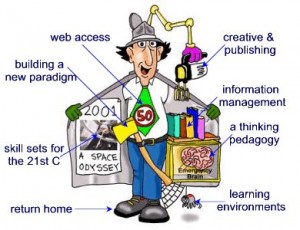This week begins our school’s first session of job-embedded professional development in year two of our technology integration and constructivist classroom instruction pilot. I am as excited about the learning possibilities as I am about the idea of growing the most highly educated staff of TPACK teachers on the planet.

As the instructional leader of our school, it is a personal promise to grow each and every teacher in our building into the most excellent educator possible, and I will never apologize for that promise. If you are a professional educator at Benton High School, when you leave you will be a stronger, smarter, and more situationally-aware teacher than when you arrived. Promise.
In Disrupting Class, (Christensen, 2008) the author states that we all learn at different paces and have different strengths as learners. This is nothing new to us as educators. But, what I find most interesting in this book and in additional readings that Benton’s instructional coach feeds me, is that technology (laptops and web tools) offers an “interface” that facilitates differentiated learning in a classroom more than any other. The problem with that facilitation is that our teachers have never had the opportunity to learn themselves how to use them in a classroom, let alone as a learner.
Chapter Four in our The Case for Constructivist Classrooms book study, (Brooks & Brooks, 1999) we will be reading about “Posing Problems of Emerging Relevance to Students.” These are the eight pages you will be reading this month as we practice what the authors call, “learning for transfer.” Constructivist teachers, and therefore constructivist principals, pose/seek to answer ONE BIG QUESTION, give learners time to think about it, and lead learners to resources to answer it. In following this guiding principle in constructivist pedagogy, the ONE BIG QUESTION will be, “How does Wednesday’s learning fits into your practice?”
As departments, you will share your ideas to the staff, but take time to “play” with the big question first. If you haven’t done so already, Nash offers great insight to the value of play in the classroom. As you begin to try new ideas, implement new strategies, and create new problems – I suggest you seek out Mrs. Corey, our Library Media Specialist. She has an infinite volume of resources that will truly amaze you. You will not sacrifice rigor in your classroom, that’s her promise. When your department is ready, you should comment on THIS POST so that we all may learn from your experiences. I am looking forward to learning from each department in the next month!
Thanks to Google Images and salamsmkserian.blogspot.com for images used in this blog.
